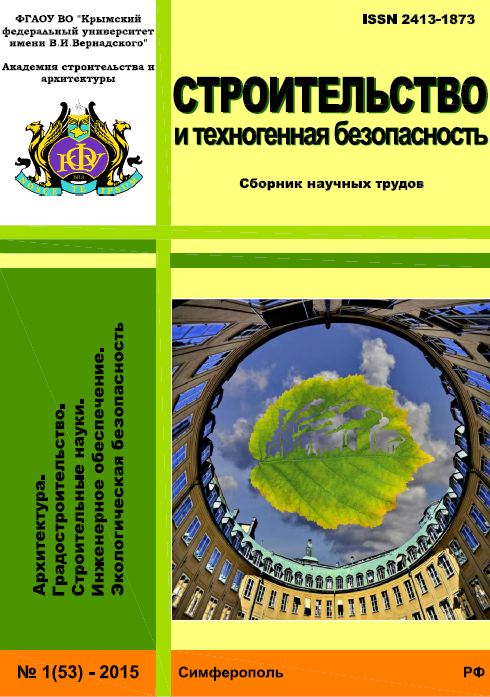This article is the first in a series aimed at defining the methodology for applying numerical modeling in predicting microclimate parameters. The article discusses the methods and materials used for the research and presents the results of a comparison between a field experiment and the outcomes of numerical modeling using the k-ε turbulence model under the combined influence of engineering systems on microclimate formation. Subject of the study: microclimate parameters and their convergence in field experiments and the application of the k-ε turbulence model. Materials and methods: The field experiment was conducted in real-world conditions in a university lecture hall using certified equipment. The evaluation of turbulence models was performed through numerical modeling in the FlowSimulation SolidWorks software suite. Results: Tables with values of air velocity and temperature in characteristic zones of the lecture hall were obtained both experimentally and through numerical modeling. Conclusions: A significant discrepancy was identified between the results of the field experiment and the numerical modeling using the k-ε turbulence model for air velocity under the combined influence of engineering systems on microclimate formation.
microclimate, experiment, turbulence models, convergence
1. Modelirovanie pritoka tepla ot solnechnoy radiacii cherez reshetochnye smart-okna / R.S. Zakirullin, I. A. Odenbah, N. M. Gun'ko [i dr.] // Academia. Arhitektura i stroitel'stvo. – 2023. – № 3.
2. Timin, V. S. Lokal'no-zonnoe nizkotemperaturnoe otoplenie plenochno luchistymi elektronagrevatelyami / V. S. Timin, I. P. Angelyuk // Stroitel'stvo i tehnogennaya bezopasnost'. – 2019. – № 14(66).
3. Ulyasheva, V. M. Chislennoe modelirovanie ventilyacionnyh processov v pomescheniyah / V.M. Ulyasheva, T. A. Dacyuk, E. A. Anshukova // Kachestvo vnutrennego vozduha i okruzhayuschey sredy : Materialy XXII
4. Zaycev O.N. Angeluck I.P., Toporen S.S. Experimental study of the aerodynamic resistance of a conical-spiral heat exchanger of the outgoing flue gases // IOP Conf. Series: Materials Science and Engineering.
5. Informacionnaya model' programmnogo kompleksa dlya optimizacii i upravleniya sistemami ventilyacii na osnove pryamogo gazodinamicheskogo modelirovaniya / M. A. Butenko, D. V. Burnos,
6. Luchshenie ekspluatacionnyh harakteristik ventilyacionnyh sistem sovershenstvovaniem ih konstruktivnyh elementov / V. N. Andriychuk, V.I. Sokolov, N. D. Andriychuk, T. E. Shevcova
7. Uvarov, V. A. Modelirovanie sistemy vozduhoobmena hrama Aleksandra Nevskogo d. Kozhevennoe / V. A. Uvarov, A. G. Kochev // XIII Vserossiyskiy Festival' nauki : Sbornik tezisov, Nizhniy Novgorod,
8. Yastrebov A.V. Rekuperaciya vozduha: vidy, principy raboty, funkcii / A.V.Yastrebov, V.N. Zekin // Mezhdunarodnyy nauchnyy zhurnal «VESTNIK NAUKI» №4 (49) T.1 Aprel' 2022 g.
9. Abuova, G. B. Modeli upravleniya mikroklimatom v pomeschenii / G. B. Abuova, E.P. Kravchenkova, I. Yu. Petrova // Perspektivy razvitiya stroitel'nogo kompleksa : Materialy XIV Mezhdunarodnoy nauchno-
10. Vieira Zezzo L., Pereira Coltri P., Dubreuil V. Microscale models and urban heat island studies: A systematic review //Environmental Monitoring and Assessment. – 2023. – T. 195. – №. 11. – S. 1284.
11. Dacyuk T.A. Novaya tehnologiya proektirovaniya sistem obespecheniya mikroklimata zdaniy / T. A. Dacyuk, V. F. Vasil'ev, V.V. Deryugin, Yu.P. Ivlev // Sanitarnaya tehnika. – 2005. – № 3(4). – S. 57-62.
12. Ziganshin, A. M. Vihrevaya ventilyaciya. Profilirovannye elementy sistem ventilyacii snizhennoy energoemkosti / A. M. Ziganshin, K.I. Logachev. – Izhevsk : Izhevskiy institut komp'yuternyh





